It's been a while since the last article on Kemp and Exchange, so here's an updated version. For this test, I used a Kemp Loadmaster VLM-5000 (which is available for free with people with MCP ID for HomeLab) and Exchange 2019. The Loadmaster firmware used is 7.2.48. The Loadmaster is operated in the classic 2-arm configuration, which means that the servers (including Exchange) are located in a different VLAN to the clients. In my test environment, Exchange is located in subnet 172.16.14.0/24 and the clients in network 192.168.100.0/24. The Loadmaster has one interface in each of the two networks and acts as an L7 load balancer.
Basic configuration Kemp Loadmaster for Exchange
There are three small settings that Kemp recommends for the use of Exchange. Firstly, "Subnet Originating Requests" should be activated under "System Configuration > Miscellaneous Options > Network Options". This setting makes sense in most configurations anyway. With this setting, the loadmaster routes the traffic via the respective interface in the subnet of the real server and not via the default gateway if the servers are located in different networks:
To avoid problems with the Exchange web services or Outlook for Mac, the settings "Additional L7 Header" and "100-Continue Handling" are important. Both settings can be found under "System Configuration > Miscellaneous Options > L7 Configuration":
That's it with the basic settings and you can start with the AD configuration.
Configuration SSO / Active Directory
In order for ESP to work later, the connection from the loadmaster to the Active Directory must be established. A new "Client Side Sigle Sign On Configuration" is added to the loadmaster for this purpose:
The domain controllers can be added to an LDAP endpoint under "Manage LDAP Configuration":
An LDAP enpoint must be created so that the Domian controllers can be added:
The domain controllers with port are specified as LDAP servers. Domain controllers use port 636 for the LDAPS protocol. In addition, a user must be specified who has read access to the Active Directory. A normal domain user account is sufficient here:
The new LDAP endpoint can now be selected in the SSO configuration. The logon format should be set to "Principalname":
The new Client Side SSO Configuration is now displayed in the overview:
The Exchange template can now be imported.
Exchange Template
Kemp offers templates for Exchange 2019 that make configuration easier. The template for Exchange 2019 can be downloaded here:
Once the template has been downloaded, it can be imported into Loadmaster:
After the import, three templates are displayed in the overview. The "Exchange 2019 HTTPS Reencrypted with ESP" template is used for this HowTo, as it generally does not require any adjustments to the Exchange configuration:
A little more data is required for the configuration; this is collected in the next section.
Required data
For the configuration of ESP in connection with Exchange 2019 in the following sections of the article, three URLs are important for the Exchange environment:
- Allowed Virtual Hosts
- Pre-Authorization Excluded Directories
User Password Form
Both URLs must first be determined. So that you have all the necessary data to hand when it comes to the configuration, you can copy the URLs and host names together and into Notepad so that you have all the data for the configuration to hand.
The "Allowed Virtual Hosts" are the host names under which Exchange is to be published. The host names for "Allowed Virtual Hosts" are derived from the Exchange settings for the virtual directories. Here is an example, if the configured MAPI URL corresponds to "https://mail.frankysweb.de/mapi", the "Allowed Virtual Host" for the Virtual Service is "mail.frankysweb.de":
The "Allowed Virtual Hosts" are required for each protocol (do not forget Autodiscover). The value for "Pre-Authorization Excluded Directories" is made up of the GUID of the arbitration mailbox and the SMTP domain. The URL for "User Password Form" is made up of the external URL for the OWA directory and the string "auth/expiredpassword.aspx?url=/owa/auth.owa".
I have created a small script that automatically collects the data. The script provides the data required for the configuration in the next section. The output of the script then looks something like this:
A brief explanation: The SubVS is shown in green, the name of the respective setting for the SubVS is shown in yellow and the corresponding value for the setting of the SubVS is shown in white.
The script can be downloaded here:
Certificate
The Loadmaster requires an SSL certificate so that no certificate warnings appear later in the browser or Outlook. A certificate from an internal PKI or a certificate from a public CA can be used here. Free certificates from Let's Encrypt can also be imported here.
For this HowTo I use a certificate from Let's Encrypt. For the sake of simplicity, I have downloaded the Let's Encrypt certificate from the website SSLForFree related. For the certificate, it is important that all DNS names that have been configured on the Exchange servers are present on the certificate. The data from the script mentioned above can be used here, and all host names listed as "Allowed Virtual Hosts" under the first point "Exchange 2019 HTTPS Rencrypted with ESP - Authentication Proxy" must be present on the certificate. Of course, a wildcard certificate can also be used here.
An existing certificate can be added under "Certificates & Security" under "Import Certificate":
When importing, the certificate must be in PEM or PFX format:
Once the certificate has been imported, it is displayed in the overview:
All preparations for the configuration are now complete and the configuration can be started.
Loadmaster configuration for Exchange
As the template for Exchange 2019 has already been imported, a new virtual service can now be created using the template. In addition to an IP for the virtual service, the corresponding template must also be specified, in this case "Exchange 2019 HTTPS Reencrypted with ESP":
Once the new Virtual Service has been created, the settings appear directly. The first SubVS is now adjusted under the settings of the SubVSs ("SubVirtualServices"):
In the SubVS settings, the Exchange server(s) are now first added as a real server:
The IP addresses of the Exchange servers are now added as real servers. To add the Exchange servers directly to all SubVSs, the checkbox "Add to all SubVSs" can be activated:
After the Exchange servers have been added as real servers, the individual SubVSs should be displayed in the overview with a green checkmark and the previously imported certificate can now be assigned to the virtual service:
The certificate is displayed in the "Available Certificates" list and can be assigned to the Virtual Service:
You can now start configuring ESP. To configure ESP, the virtual service is adapted using "Modify":
Each individual SubVS must now receive the corresponding ESP configuration. The required values have been provided by the script, these settings are now required. Except for the SubVS "Exchange 2019 HTTPS Reencrypted with ESP - OWA", the configuration is the same for all SubVSs, so here is the configuration for all SubVSs (except OWA):
The previously created "SSO Domain" is now selected in the ESP settings of the SubVSs and the "Allowed Virtual Hosts" are configured:
The script provides the data for the Allowes Virtual Hosts, here as an example:
Some SubVSs have the value "Delegate to Server" configured as "Client Authentication Mode". This setting can be left as it is and only "Allowed Virtual Hosts" needs to be configured:
The "Allowed Virtual Hosts" and the "SSO Domain" are now configured for all SubVS with the exception of "Exchange 2019 HTTPS Reencrypted with ESP - OWA". To do this, each individual SubVS must be customized.
The SubVS "Exchange 2019 HTTPS Reencrypted with ESP - OWA" requires a little more configuration, so here are the settings provided by the script:
The data from the script is now entered in the ESP configuration of OWA:
Once all SubVSs have been adjusted, the tests can be started.
Tests
To test the configuration first, the HOSTS file can now be adapted on a client. In my test environment, I have redirected "mail.frankysweb.de" and "autodiscover.frankysweb.de":
Outlook and OWA in particular can now be tested. For the OWA test, it is advisable to use the incognito mode of the browser to bypass saved logins. The Kemp Loadmaster now offers a login mask for the OWA page (not exactly pretty):
The browser and Outlook should not issue any certificate warnings and normal working should be possible. If everything is working, the DNS and router can be adjusted.
Customization DNS and router / firewall
If the tests were successful, the adjustment to the HOSTS file can be undone. The DNS configuration is adjusted so that all clients now use the load balancer. The IP addresses for "mail.frankysweb.de" and "autodiscover.frankysweb.de" are now changed to the IP address of the loadmaster's virtual service:
As soon as the clients update the DNS cache, the load balancer is used to access Exchange. In addition to the change in the DNS, the NDAT entry on the router or firewall usually has to be changed; the IP is now also changed to the IP of the virtual service for the NAT entries for ports 443 and 80. This means that external clients also use the load balancer.
Customization (optional)
If you don't like the Kemp login form, you can replace it. Here is a template with which you can create your own login form:
This allows the design to be adapted to the corporate identity. Alternatively, you can also download a prettier login form or an article on how to create one here:







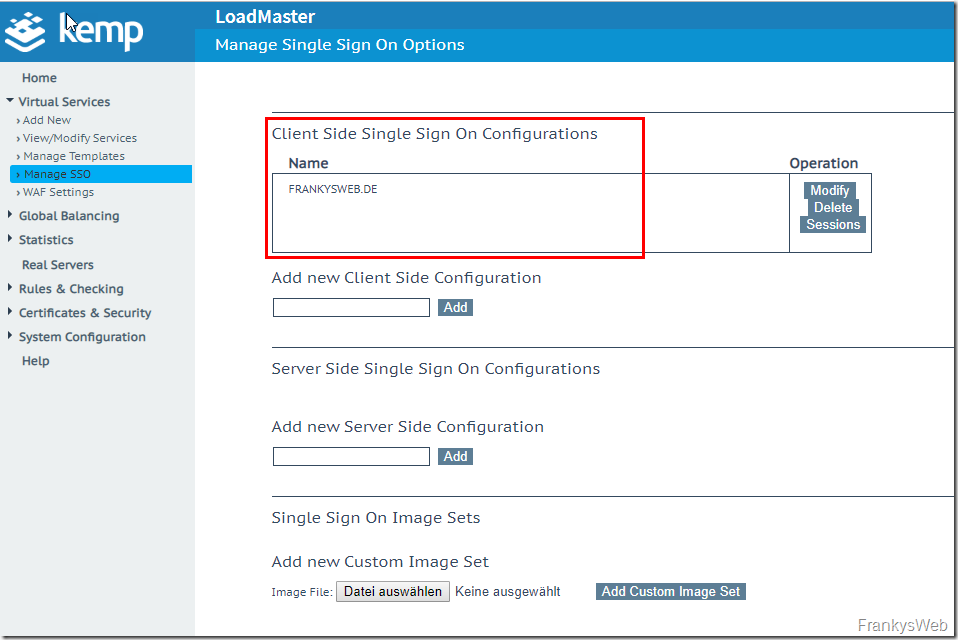
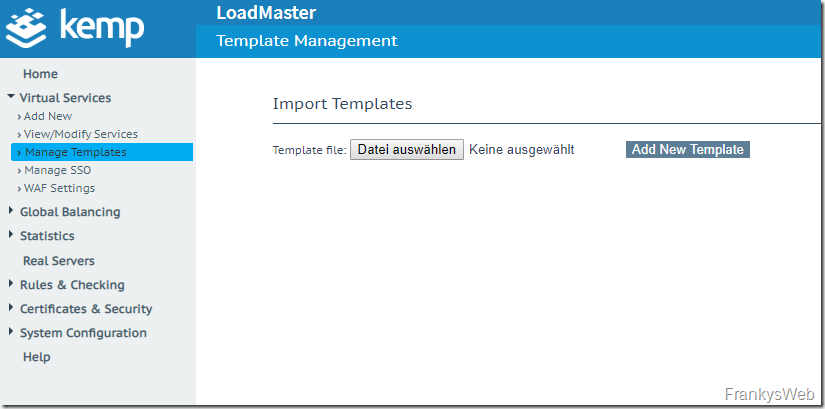

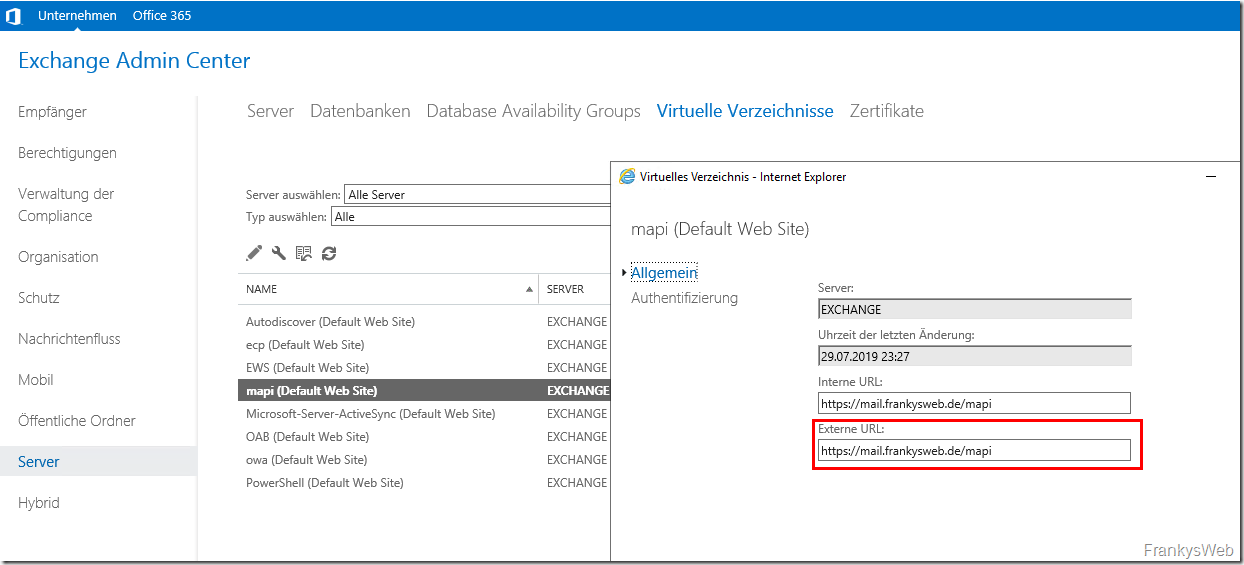
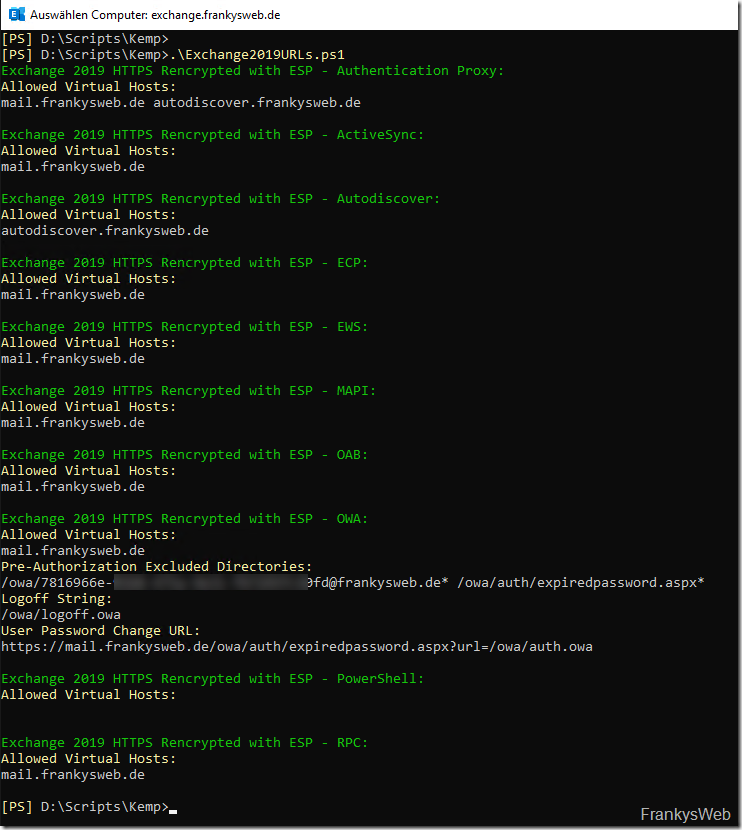
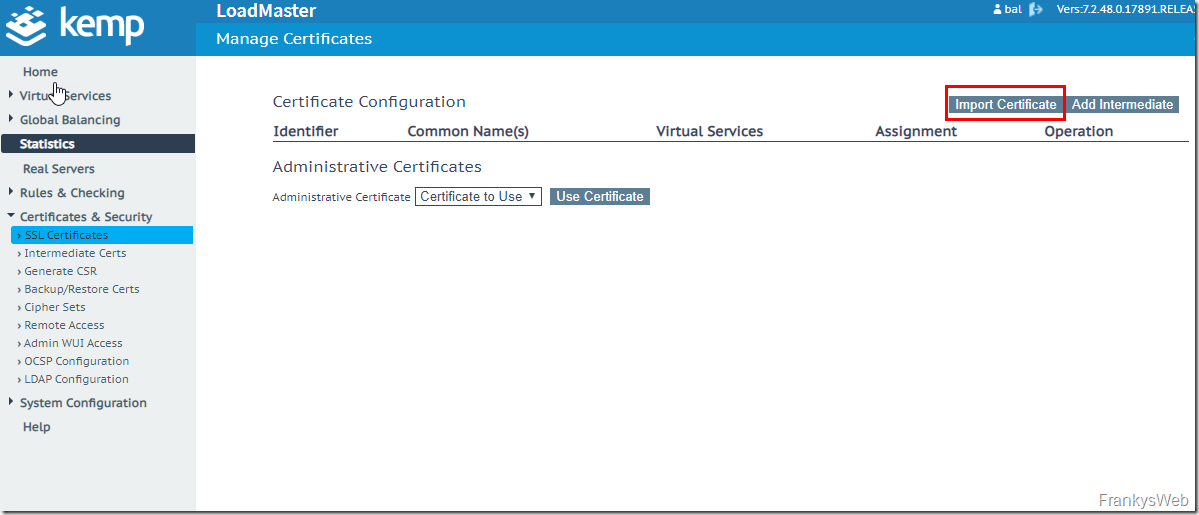
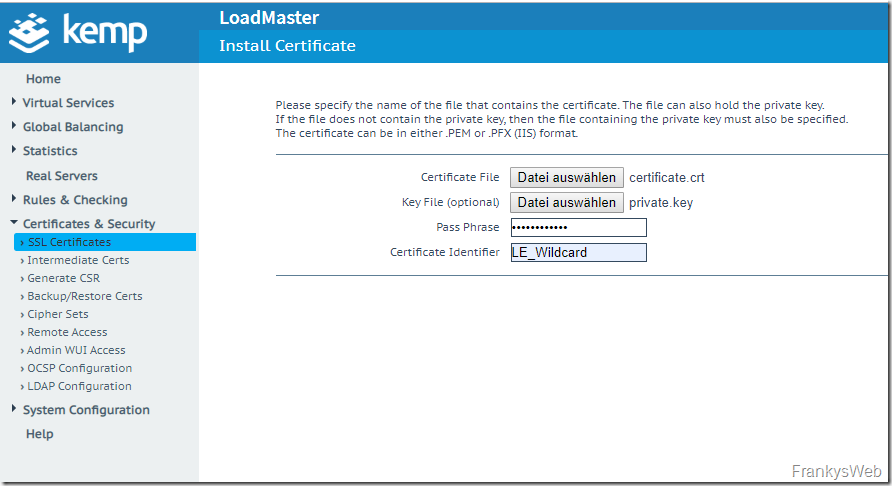
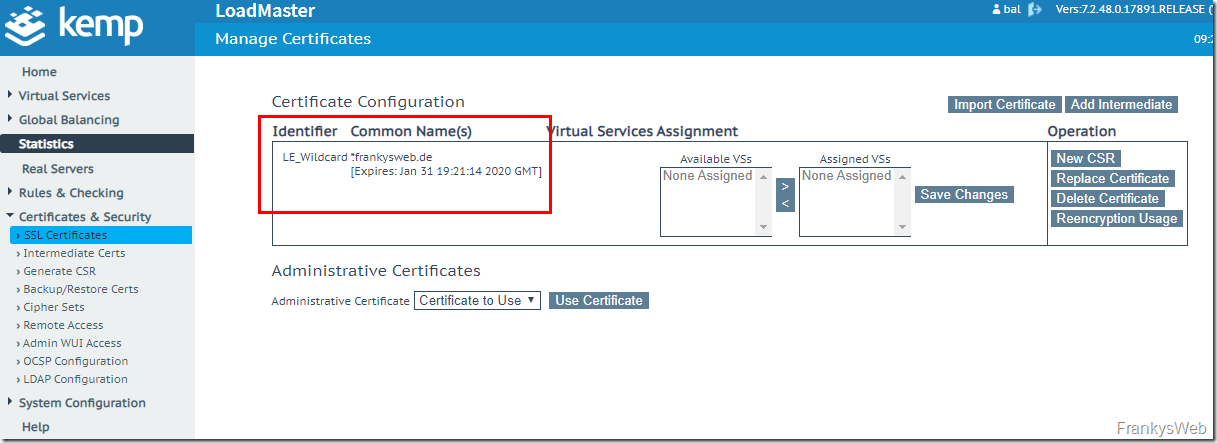
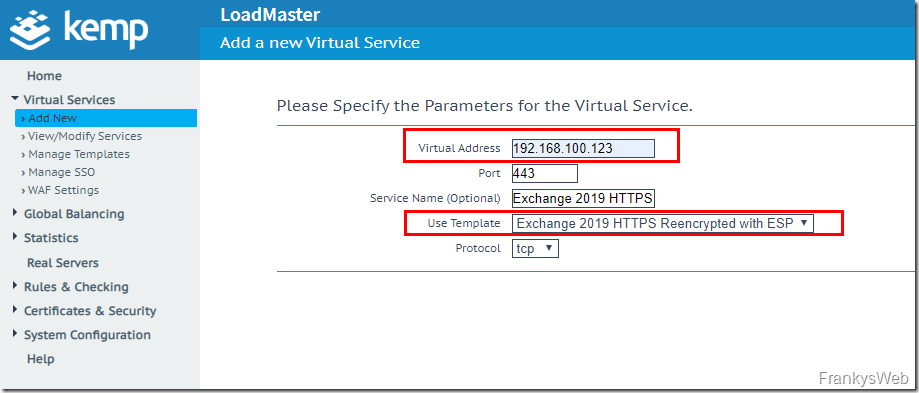
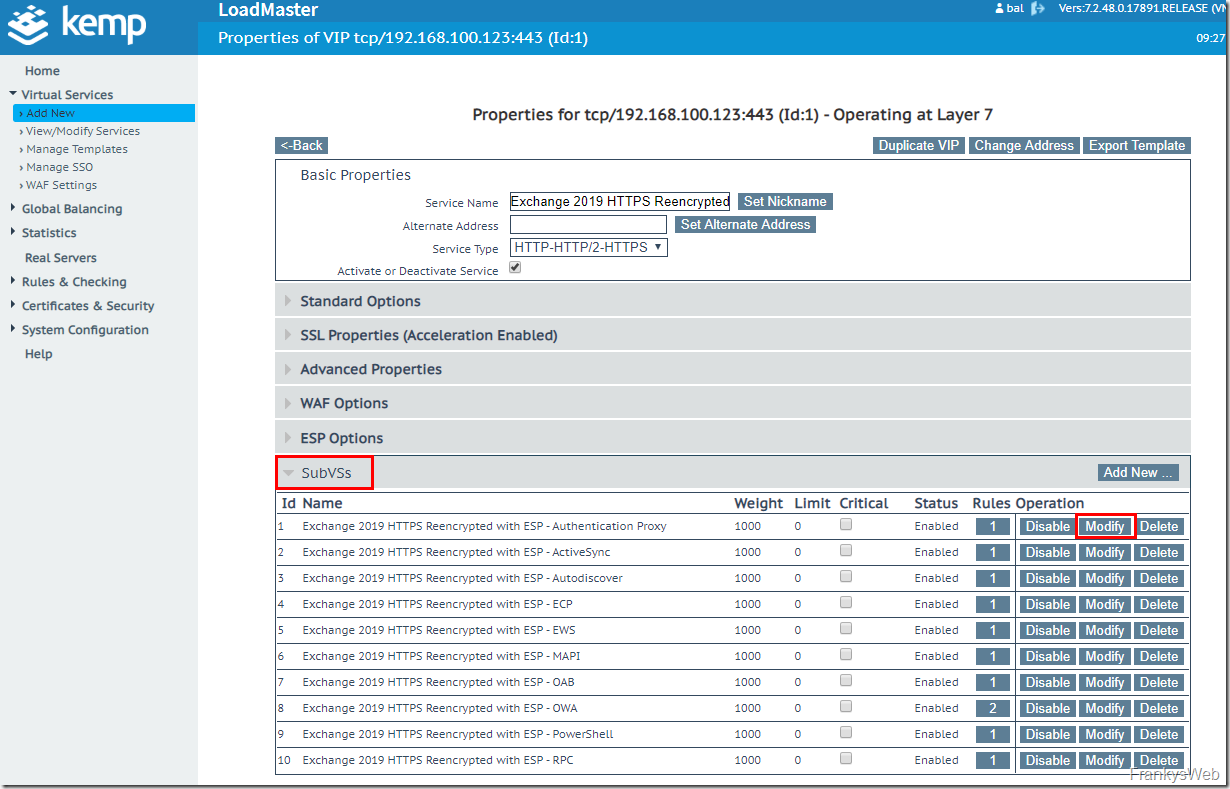
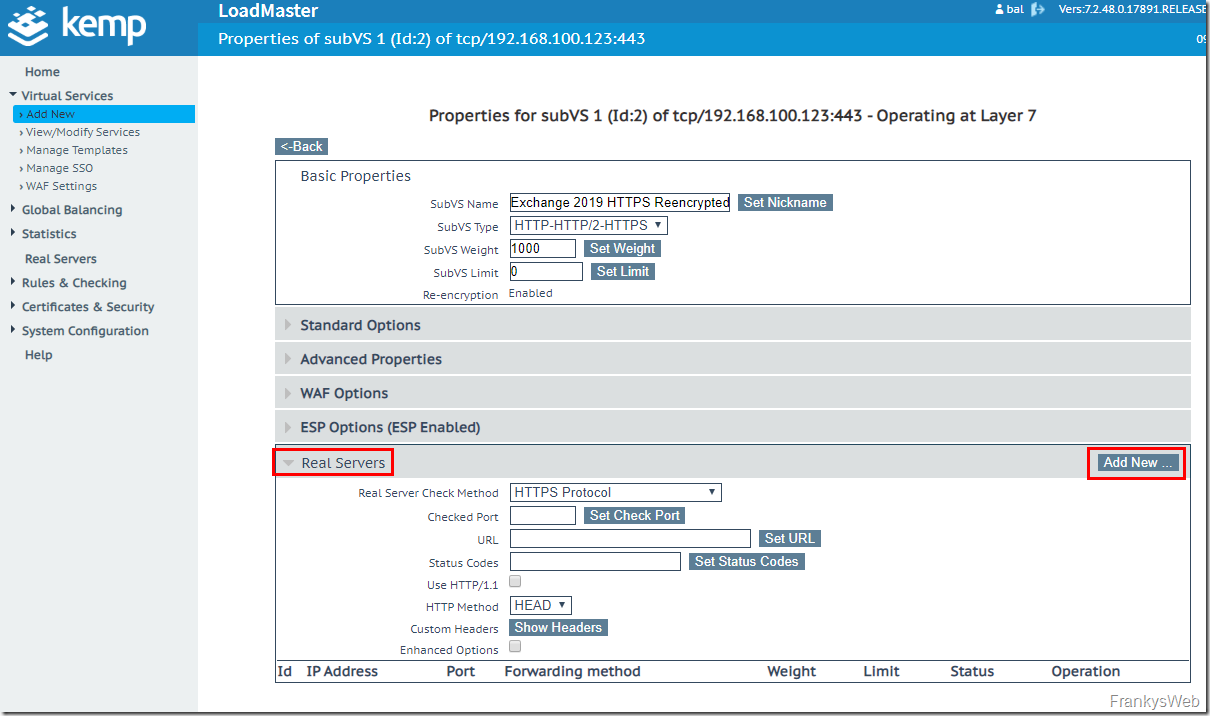

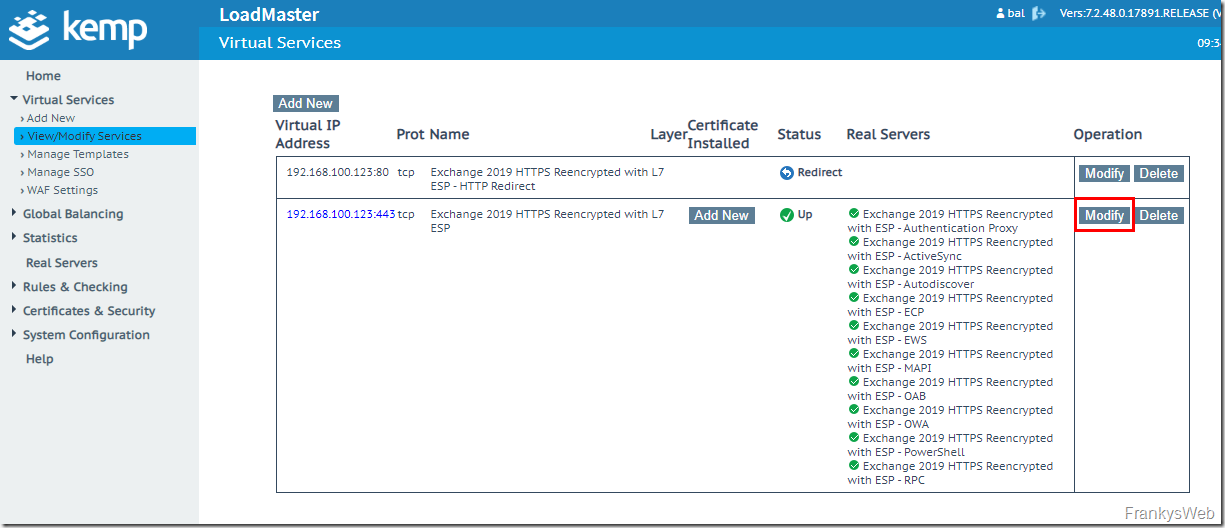
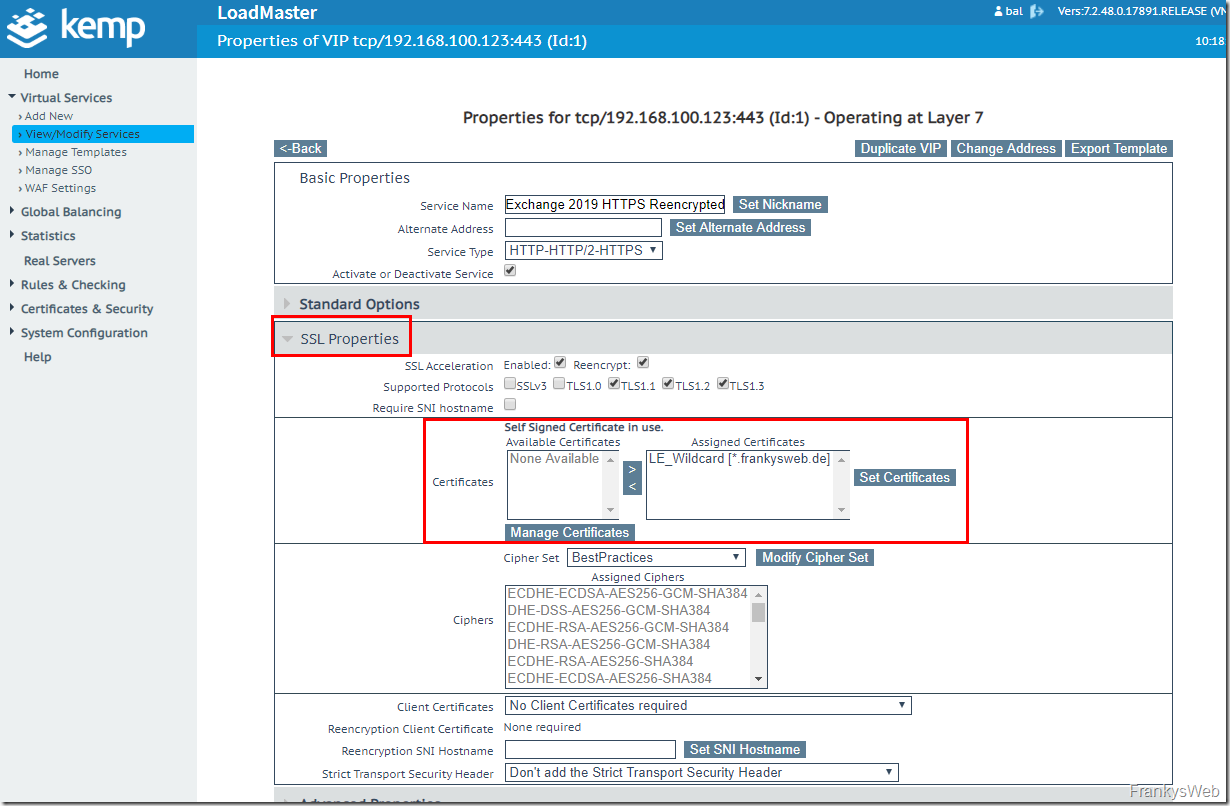
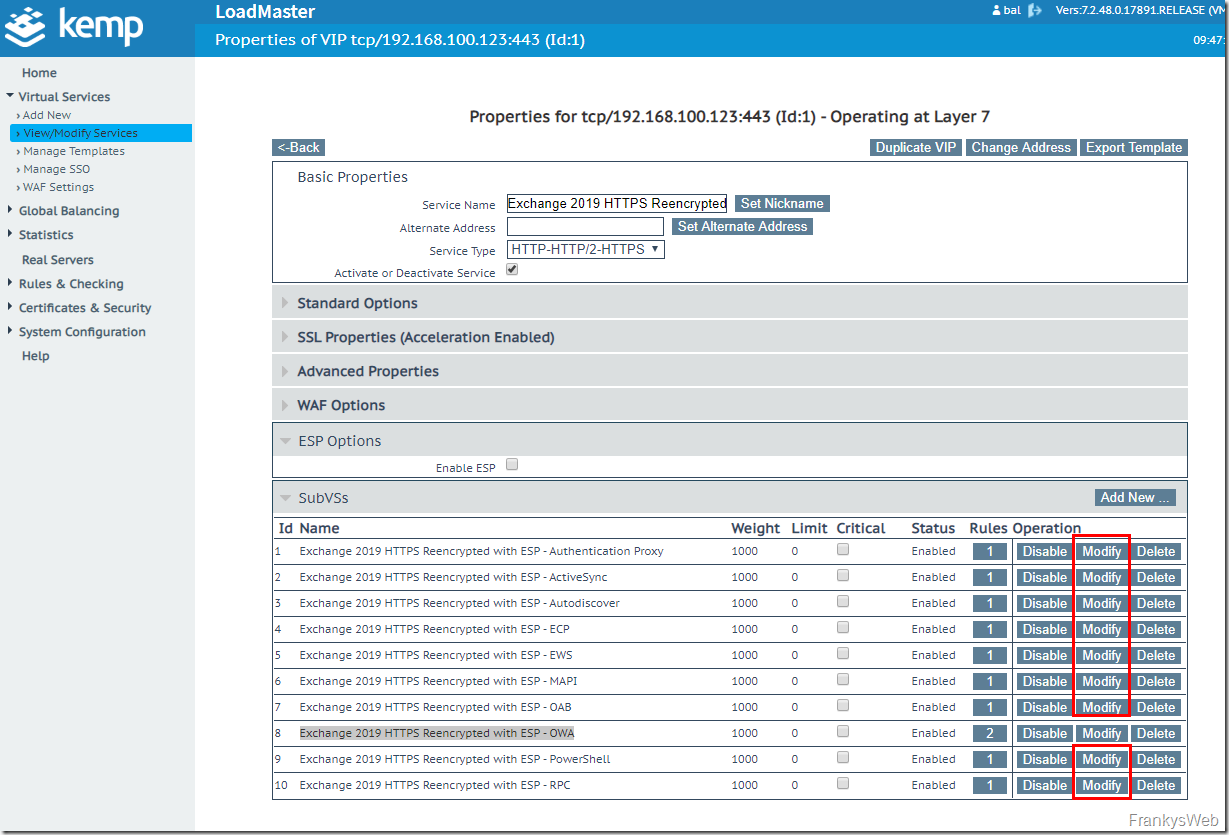
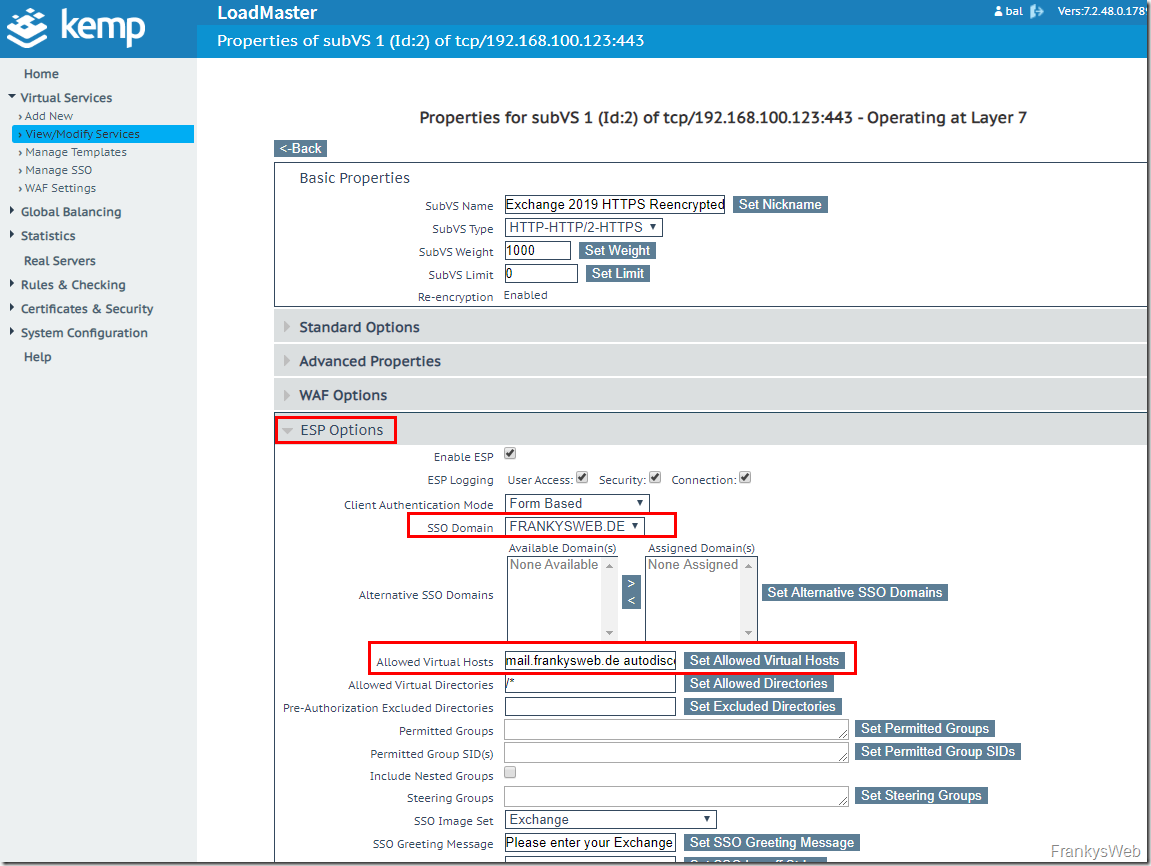

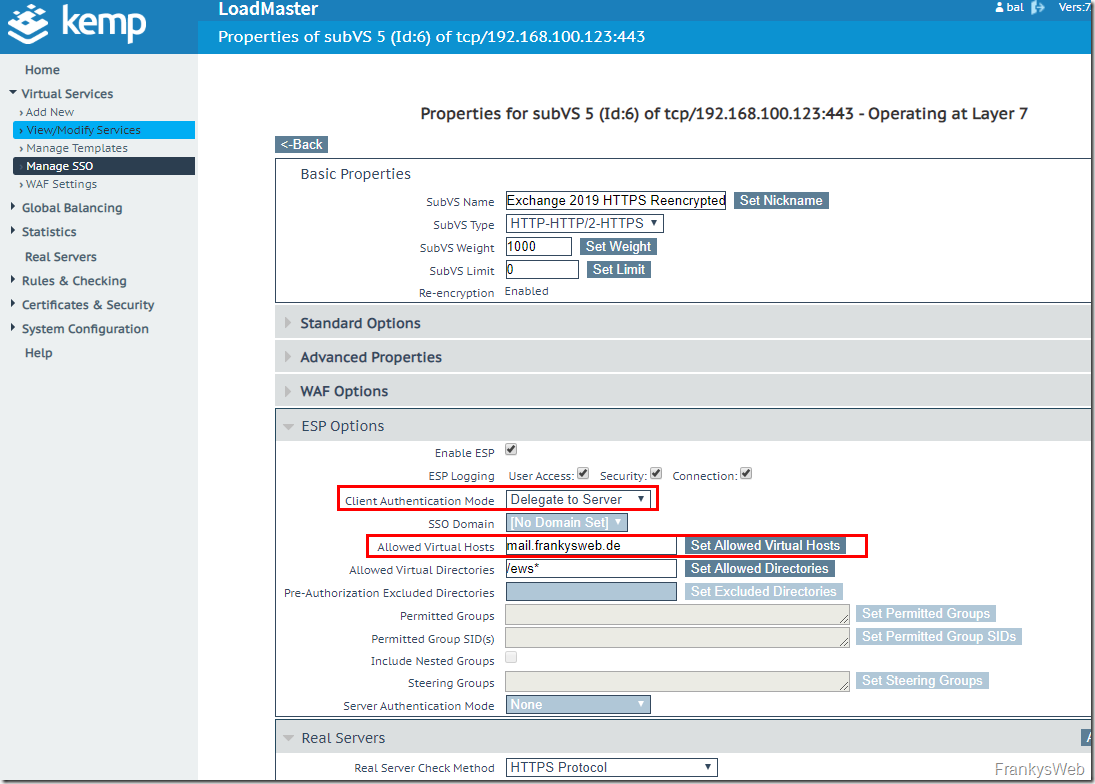

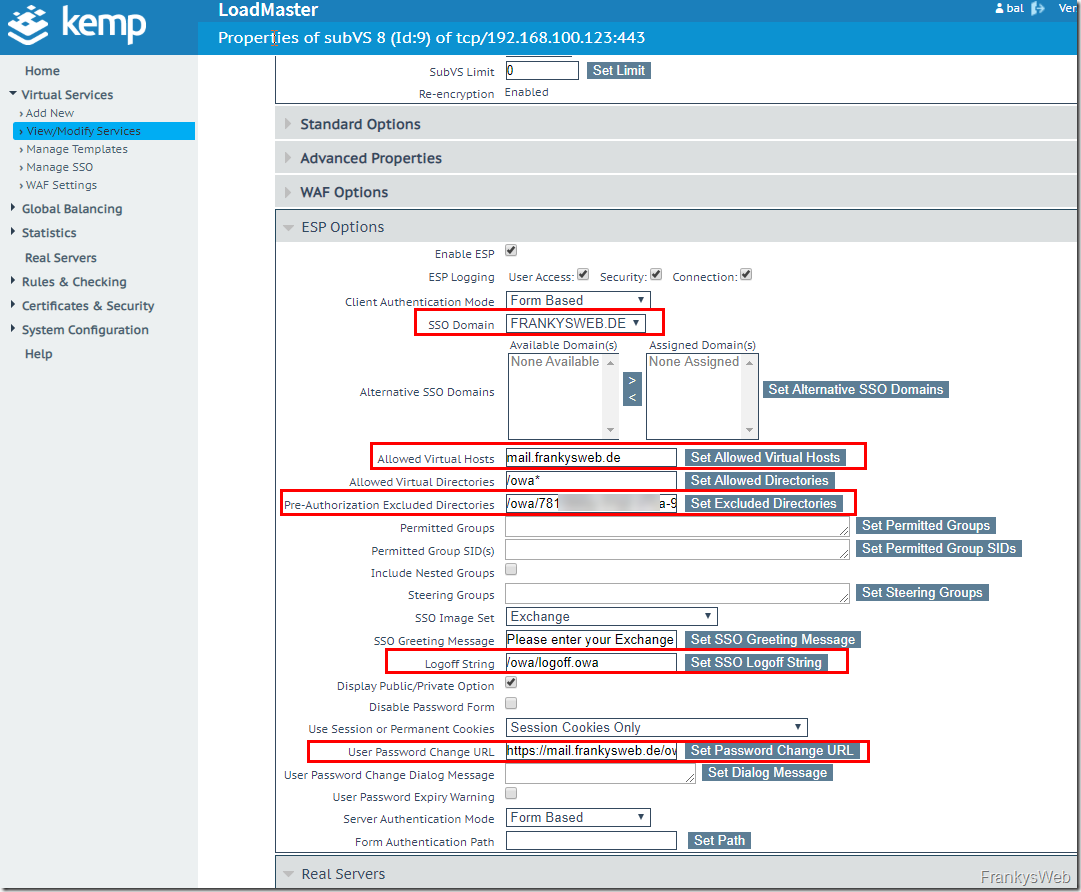
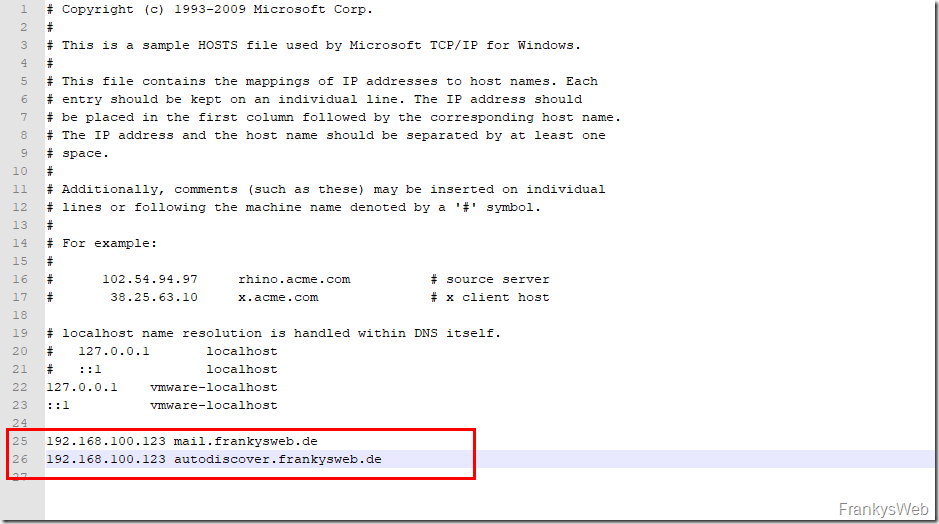
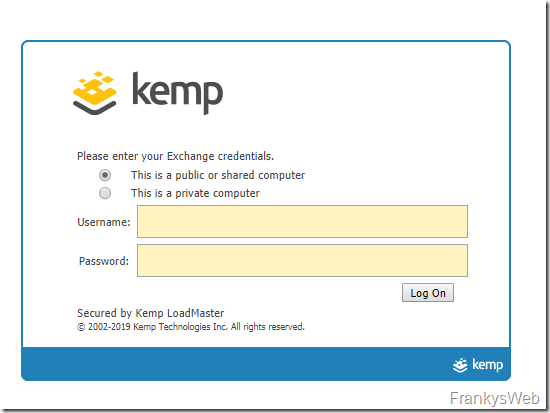
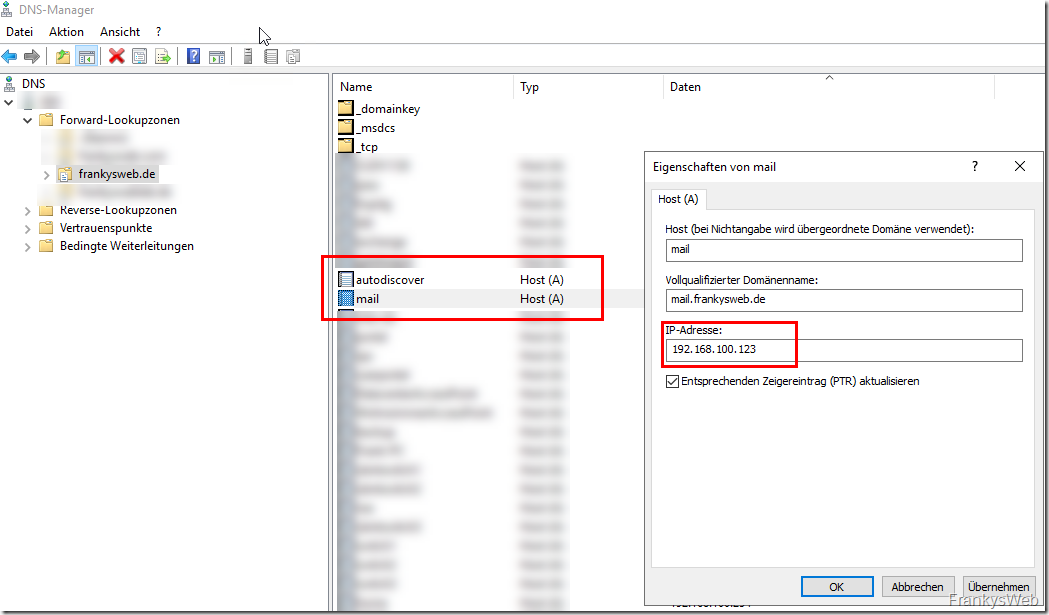
Hallo,
ich habe den LB von Kemp schon ewig im Einsatz und finde ihn Klasse.
Seit einiger Zeit, ich kann nicht sagen ob es mit den vielen neuen Versionen in 2024 zusammenhängt, habe ich das Problem das ich mich zwei mal anmelden muss. Beim ersten mal steht im Browser die Domain.tld/OWA, bei der zweiten Anmeldung nur Domain.ltd. Ich komme bei der Fehlrsuche nicht wirklich weiter, gibt es eine Doku (deine ist super, es haben sich aber auch Punkte geändert, vielen Dank für deine Arbeit!) die Kemp etwas mehr erklärt?
Ich habe die Dienste auch eingeschränk, ich habe bis auf ActiveSync, ECP und OWA alles deaktiviert, weil ich es nur für AS und OWA nutzen möchte.
Grüße, Frank
Hat vielleicht jemand eine Idee, warum Outlook 365 kein Problem hat zu starten wenn Userprofil ist im Online-Modus und wenn Cache-Modus benutzt wird, kommt beim Start ein Anmeldefenster und die Anmeldung nicht funktioniert obwohl gleiche Anmeldedaten verwendet werden wie beim Online-Modus?
Gute Anleitung, eine Anmerkung habe ich: Die „User Password Change URL“ und „User Password Change Dialog Message“ müssen nicht im OWA SubVS, sondern unter „AuthProxy“ eingetragen werden, da es sonst nicht möglich ist, das Kennwort via ESP OWA zu ändern. Der Link für die Passwortänderung wird nicht eingeblendet und es kommt nur Login failed. Zusätzlich ist es zwingend erforderlich, dass ein Text (z. B. „Your Account has expired. Please change your password.“) unter „User Password Change Dialog Message“ eingetragen ist, da es sonst nicht funktioniert. Ich habe es aber mit Exchange 2019 getestet und es hat nur funktioniert, wenn beide Felder im AuthProxy gefüllt sind. Wenn man es zusätzlich im OWA SubVS einträgt geht es auch noch, aber die Einträge haben keine Relevanz für die Funktion. Sofern man die Felder im OWA SubVS ausfüllt, können die User nur durch das direkte Öffnen des Links ihr Kennwort neu setzen. Aber welcher User kennt den Link auswendig ?
Die offizielle KEMP-Doku sagt hier zwar auch was anderes, bzw. es ist nicht eindeutig beschrieben.
https://support.kemptechnologies.com/hc/en-us/articles/115003676151-How-to-configure-ESP-Forms-Based-to-Forms-Based-Authentication-FBA-with-Exchange
„To enable the password reset feature, you must adjust the AUTH proxy and the OWA SubVS.“ – Das stimmt so nach meinen Tests nicht, es reicht wie gesagt, wenn beides unter AuthProxy eingetragen ist. Im OWA ist nur unter „Pre-Authorization Excluded Directories“ mit „/owa/GUID@contoso.de* /owa/auth/expiredpassword.aspx*“ erforderlich und natürlich der Logoff String.
Moin zusammen,
hat mal jemand getestet ob man bei einer Migration von Exchange 2016 auf Exchange 2019 die Kemp Konfigruation (explizit den virtuellen Service) belassen kann? Ich habs gemacht, hatte damals das normale 2016er Template (ohne reencrypt) verwendet. Es funktioniert auch soweit. Man kann aber keinen Chrome mehr nutzen?! Firefox, Safari, IE alles kein Problem nur kein Chrome :D Bzw. auch den neuen von Microsoft nicht. Wenn ich anstatt der Kemp VS URL direkt den Server DNS eingebe, kappt es auch mit Chrome. Liegt es wirklich an dem 2016er Template von Kemp in Verbindung mit 2019er Exchange Servern? Hängen halt 1000 Nutzer dran und das Zeitfenster ist knapp, da kann ich nicht lange experimentieren.
Hallo Frank,
danke für die gute Anleitung. Ich habe das Exchange ESP Template zusätzlich zu unserem normalen OWA Zugang auf einer anderen Public IP angelegt und die Hosts Datei auf dem Rechner entsprechend zum Testen modifiziert. Ich lande auch direkt auf der Kemp Seite und kann mich anmelden. Allerdings lande ich dann nicht direkt im OWA sondern erhalte die OWA Login Seite. Hast du einen Tip für mich?
Danke und Gruß
Sebastian
Hi Sebastian,
konntest du das Problem lösen? Hab das gleiche!
danke!
René
Hallo Rene,
nein, das Problem besteht weiterhin.
Gruß
Sebastian
Moin,
ich hatte das selbe Problem. Bei mir war die Lösung bei allen SubVS mit Form Based auch Server Authentication Mode auf Form Based zu stellen. Hier die Anleitung dazu: https://docs.progress.com/de-DE/bundle/loadmaster-technical-note-form-based-to-form-based-authentication-ga/page/Introduction.html
Moin,
ich habe gerade meine ersten KEMP VLMs in Betrieb genommen und die Exchange 2016 Templates zur Einrichtung der Virtual Services verwendet.
Leider kann ich nun keine PSSession mehr per ConnectionUri zu den Exchange-Servern aufbauen.
Auzug aus der ISE:
$session = New-PSSession -ConfigurationName Microsoft.Exchange -ConnectionUri http://mail.domain.de/powershell -AllowRedirection
Import-PSSession $session -AllowClobber
WARNUNG: Ihre Verbindung wurde an den folgenden URI umgeleitet: „https://mail.domain.de/powershell?PSVersion=5.1.17763.771 “
New-PSSession : [mail.domain.de] Beim Verbinden mit dem Remoteserver „mail.domain.de“ ist folgender Fehler aufgetreten: Error occurred during the Kerberos reponse.
Jemand ne Idee oder einen Tip für mich?
Danke und beste Grüße
Bent
Hi,
wenn ich das richtig sehe sollte eigentlich wenn https://mail.domain.tld/ aufgerufen werden automatisch https://mail.domain.tld/owa weitergeleitet werden. Zumindest sehe ich bei dem SubVS ein Content Rule die für denn Root Pfad greift.
Allerdings funktioniert das in meiner Testumgebung nicht. Aus irgendeinem Grund bekomme ich beim Root Pfad immer ein Access denied. Wenn ich /owa ode /ecp aufrufe funktioniert alles wie es soll.
Hab ich vielleicht irgendwo was vergessen einzustellen?
LG
Daniel
Hallo Daniel,
damit die Umleitung funktioniert, musst du im OWA SubVs in den ESP Einstellungen unter „Allowed Virtual Directories“ noch „/“ (Schrägstrich ohne ANführungszeichen hinzufügen. Die Einstellung für „Allowed Virtual Directories“ sollte also so aussehen:
/owa* /
Gruß,
Frank
Hallo Frank,
danke genau das wars nun funktioniert alles wie es soll.
HI Daniel,
ganz einfach die Regel steht hinter dem ESP Modul. UNd das erlaubt nur /owa* also wird man mit root geblocked.
Ich würde die root auf owa wandel regel daher auf den Hauptservice legen, das die wandlung bereits stattgefunden hat, bevor man im Sub Service in das ESP Modul fällt.
Hi Frank,
ich kann mich Erik nur anschließen. Sehr schön geschrieben. Ich bin mittlerweie im dritten Jahr KEMP Zertifiziert und habe das Thema noch nie so auf den Punkt gebracht gesehen.
Weiter so.
LG
Timbo
Hi Frank,
warum nutzt du nicht gleich das PowerShell Modul vom Kemp und setzt die Directory direkt via „Set-AdcVirtualService – AllowedHosts „HOSTNAME“ -AllowedDirectories „/test““
Grüße Michael Kunesch
Sehr schön geschrieben!
Danke